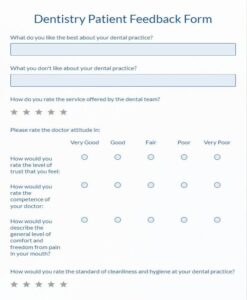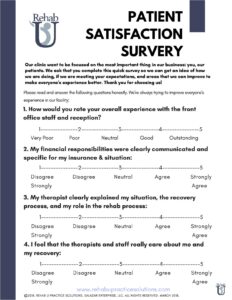In today’s competitive healthcare landscape, understanding what your patients truly think about your pharmacy isn’t just a good idea; it’s absolutely essential for growth and success. Imagine knowing precisely what makes your customers happy, what frustrates them, and where you can improve their experience. This isn’t guesswork; it’s data-driven insight that can transform your operations and build lasting loyalty. A well-crafted patient satisfaction survey is your direct line to these invaluable perspectives, offering a clear roadmap for enhancing services and distinguishing your pharmacy from the rest.
Developing an effective patient feedback mechanism doesn’t have to be daunting. The goal is to gather actionable feedback efficiently, allowing you to fine-tune everything from wait times and staff interactions to medication counseling and store accessibility. By proactively addressing patient needs and concerns, you not only improve their current experience but also foster a sense of trust and care that encourages repeat visits and positive word-of-mouth. This article will guide you through the process of creating and utilizing a robust pharmacy patient satisfaction survey template, designed to capture the insights you need to thrive.
Why Understanding Patient Satisfaction is Crucial for Your Pharmacy
For any pharmacy aiming for excellence, patient satisfaction isn’t merely a metric; it’s the heartbeat of your business. Happy patients are loyal patients, and loyal patients are the foundation of a thriving practice. When you truly understand what your patients value, what their pain points are, and what their expectations are, you gain an unparalleled advantage. This understanding allows you to tailor your services, refine your operations, and ultimately provide a healthcare experience that stands out in a crowded market.
Think about it from a patient’s perspective. They are often coming to you during a time of need, perhaps feeling unwell or dealing with complex medication regimens. A positive, supportive, and efficient experience can make all the difference. Conversely, long wait times, unclear communication, or a perceived lack of empathy can quickly erode trust and send them looking for alternatives. A comprehensive survey acts as your early warning system, highlighting areas of concern before they escalate into larger problems, while also identifying your strengths that you can further leverage.
Beyond retention, patient satisfaction significantly impacts your pharmacy’s reputation and financial health. Positive experiences lead to word-of-mouth referrals, which are arguably the most powerful form of marketing. Patients who feel heard and cared for are more likely to recommend your pharmacy to friends and family, expanding your reach organically. Furthermore, many healthcare systems and insurance providers are increasingly tying reimbursements and quality metrics to patient satisfaction scores, making it a critical component of your overall operational strategy.
Ultimately, investing in patient feedback through a dedicated pharmacy patient satisfaction survey template demonstrates a commitment to continuous improvement and patient-centric care. It’s about building relationships, not just filling prescriptions. It empowers you to make informed decisions based on real-world experiences, ensuring your pharmacy evolves in a way that truly serves the community it aims to help.
Key Areas to Cover in Your Patient Satisfaction Survey
- Staff Interaction and Professionalism: How friendly, helpful, and knowledgeable were the pharmacy staff?
- Wait Times and Efficiency: Was the prescription filling process timely? Was checking out efficient?
- Medication Counseling: Did the pharmacist clearly explain medications, dosages, and potential side effects? Were your questions answered thoroughly?
- Pharmacy Environment: Was the pharmacy clean, organized, and easily navigable?
- Accessibility and Convenience: Was parking available? Were the hours convenient? Was it easy to access the services you needed?
- Overall Experience: Would you recommend this pharmacy to others? What was your overall impression?
- Specific Services: If applicable, questions about immunizations, compounding, or medication synchronization services.
Crafting and Implementing Your Effective Patient Survey
Once you understand the ‘why’ behind patient satisfaction surveys, the next step is to focus on the ‘how.’ Designing a survey that effectively captures meaningful insights requires careful thought and strategic planning. The goal is not just to collect data, but to collect the right data in a way that encourages participation and provides actionable intelligence. This means striking a balance between comprehensive questioning and keeping the survey concise enough to respect your patients’ time.
Start by determining the best method for administration. Will it be a paper-based survey available at the counter, an online link sent via email or text, or perhaps a digital kiosk in the waiting area? Each method has its pros and cons regarding reach, data collection ease, and patient comfort. Online surveys often offer quicker data aggregation and analysis, while paper surveys can be more accessible for patients less comfortable with technology. Consider your primary patient demographic when making this choice.
When formulating questions, use clear, unambiguous language. Avoid jargon and leading questions that might sway a patient’s response. A mix of rating scales (e.g., 1-5, strongly agree to strongly disagree), multiple-choice options, and open-ended text fields will provide both quantitative data for easy analysis and qualitative insights for deeper understanding. The open-ended questions are particularly valuable as they allow patients to articulate specific experiences or suggestions that you might not have anticipated.
Promoting the survey is just as important as designing it. Make it easy for patients to find and complete. Place prominent signs, mention it at the point of sale, or include a link in follow-up communications. Emphasize that their feedback is valuable and directly contributes to improving their pharmacy experience. Once responses start coming in, the real work begins: analysis. Look for patterns, identify common themes in open-ended responses, and benchmark your results against previous surveys or industry standards. The insights gained from this analysis should then directly inform your improvement initiatives, creating a continuous loop of feedback and enhancement.
Regularly reviewing and updating your patient satisfaction survey ensures its continued relevance and effectiveness. As your services evolve or new patient needs emerge, your survey should adapt accordingly. This ongoing commitment to understanding and responding to patient feedback is a powerful testament to your pharmacy’s dedication to providing exceptional care and fostering a truly patient-centric environment. It’s an investment that pays dividends in patient loyalty, operational efficiency, and a stronger community presence.
Harnessing the power of patient feedback is more than just good business practice; it’s about building stronger relationships within your community. By actively seeking to understand and respond to the needs of those you serve, your pharmacy not only enhances its operational efficiency but also cultivates a reputation for compassionate, patient-first care. The insights gleaned from a well-structured feedback mechanism provide a clear roadmap for continuous improvement, ensuring that every visit to your pharmacy is a positive and reassuring experience.
Embracing this proactive approach to patient care truly sets your pharmacy apart. It demonstrates a genuine commitment to excellence and a willingness to adapt based on direct input from the very people who matter most: your patients. As you continue to refine your services based on their valuable perspectives, you’ll find that not only do patient satisfaction scores climb, but your pharmacy becomes an even more trusted and indispensable part of the community it serves.



